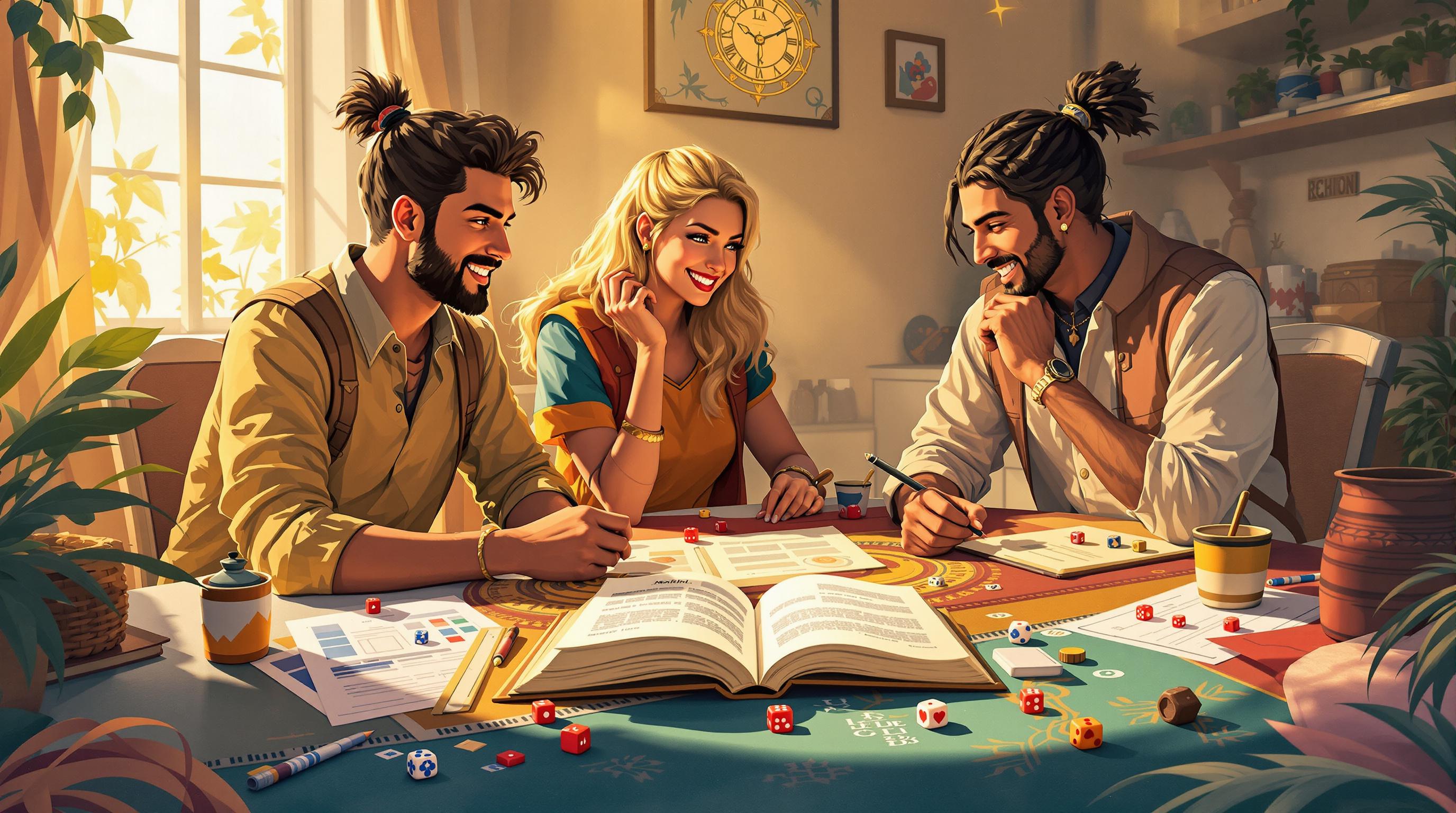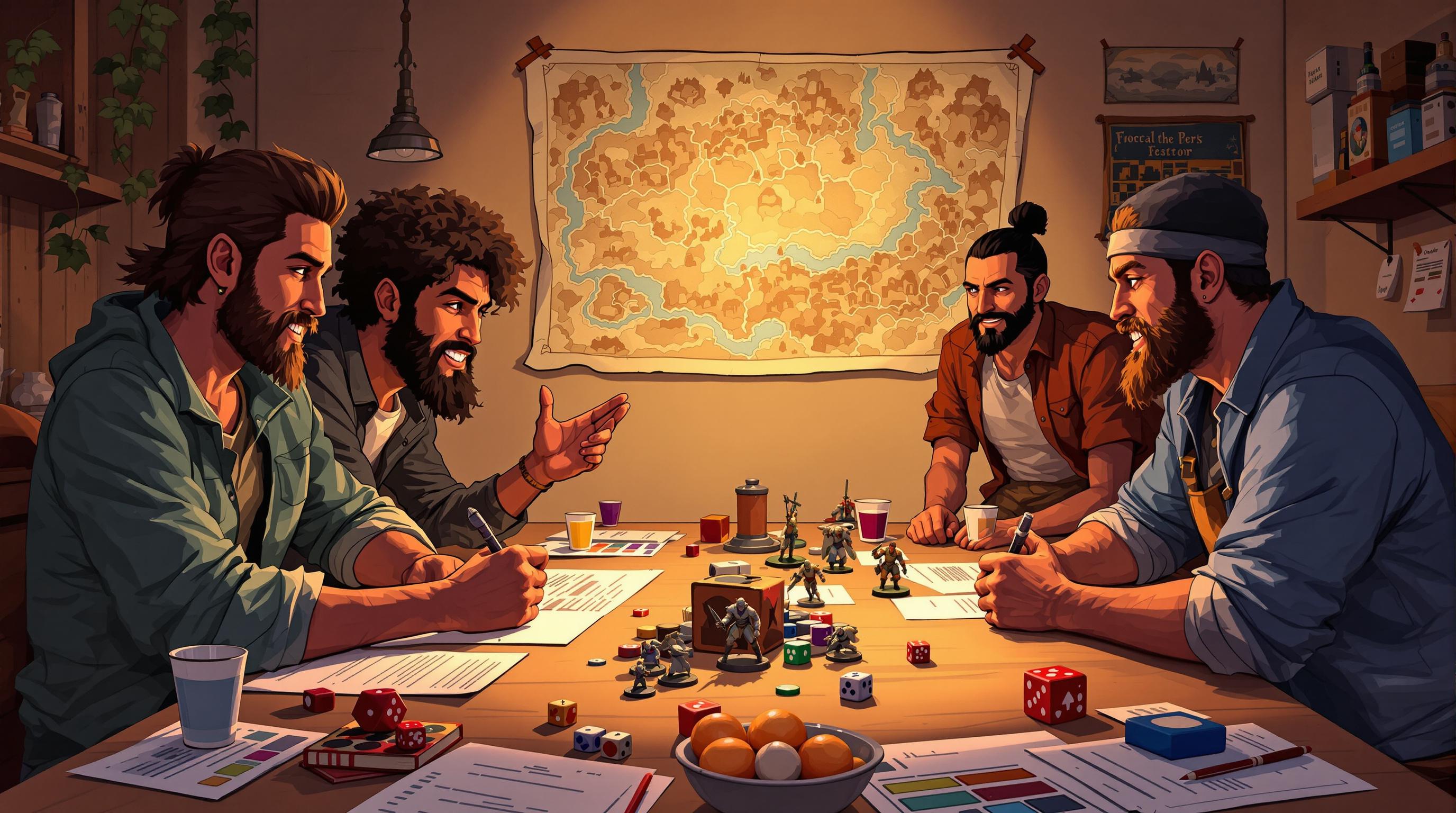Cliffhangers are a great way to keep your tabletop RPG sessions exciting and your players eagerly anticipating the next game. Here are 8 simple tips to create unforgettable cliffhangers:
- High-Stakes Endings: Pause during life-or-death moments or tough story choices.
- Major Story Reveals: Drop game-changing secrets that spark new questions.
- Big Decisions: Stop right before players make impactful choices with real consequences.
- Immediate Dangers: Introduce sudden threats like ambushes, natural disasters, or traps.
- New Mysteries: End with questions tied to the story or characters.
- Split the Party: Separate players during danger for suspense and unpredictability.
- Mid-Scene Stops: Cut off during intense action like combat or chases.
- NPC Twists: Reveal hidden agendas or secret identities of key NPCs.
These techniques build tension, deepen your story, and keep players engaged between sessions. Plan your cliffhangers carefully to balance suspense with payoff, ensuring your group stays excited and invested in the game.
Related video from YouTube
1. Create High-Stakes Endings
High-pressure moments ramp up tension and keep players hooked between sessions. The trick? Stop the action right when characters face decisions or events that could change everything.
Here’s when to pause the game:
Life-or-Death Moments
- The group is up against overwhelming odds in battle.
- A character is about to roll their final death saving throw.
- The team is racing to escape a collapsing building.
- A key NPC ally is seconds away from execution.
These moments of immediate danger naturally build suspense. But it’s not just about survival - big choices can be just as gripping.
Tough Story Choices
- Deciding whether to save an NPC or stop a villain’s plan.
- Debating whether to trust a sketchy potential ally.
- Choosing to trade a powerful artifact to save lives.
For maximum impact, mix immediate danger with ongoing mysteries. For example, pause the session when a hidden traitor is revealed just as enemy forces close in. Now, players are left questioning both their survival and their trust in each other.
Tip: Don’t make these moments feel unfair. Give players enough information to plan during the break. Telegraphing dangers earlier helps these cliffhangers feel earned, not random.
Looking for inspiration? Check out the TTRPG Games Directory for more scenario ideas.
2. Drop Major Story Reveals
Revealing truths that shift perspectives and spark curiosity can take your campaign's story to the next level. Just like those intense, high-stakes moments that grip everyone, well-timed reveals can add depth and keep the suspense alive. These moments tie perfectly into the climactic endings we talked about earlier.
Types of Reveals
Identity Shifts
- A loyal ally turns out to be working for the enemy all along.
- A seemingly unimportant NPC is revealed to be royalty.
- An ancient artifact is a fake - so where's the real one?
Hidden Connections
- Two completely separate plotlines suddenly come together.
- A recurring merchant is tied to a player character's backstory.
World-Changing Information
- The kingdom’s founding myth is exposed as false.
- A prophecy isn’t what everyone thought it was.
- The villain’s true motives flip the story on its head.
Crafting Effective Reveals
The most impactful reveals don’t just provide answers - they open up new questions. For example, if players discover their trusted patron is actually a dragon in disguise, they’ll immediately start wondering about their patron’s real goals, past actions, and what this means for their own journey.
Timing Your Reveals
- Introduce reveals after players have invested time and energy into the story, ensuring they connect with existing plotlines.
- Space them out, giving players time to digest and react between sessions.
Building Better Mysteries
Layer your reveals carefully. Each one should feel meaningful but also hint at even bigger secrets waiting to be uncovered. Keep track of what your players know to avoid contradictions and ensure your story stays cohesive.
3. Stop Before Big Choices
Pause just before major decisions to create tension that keeps players hooked. This approach turns ordinary choices into dramatic, unforgettable moments.
Types of Decision Points
Moral Dilemmas
- Save a trusted ally or stop a disaster from unfolding.
- Decide whether to believe a former villain's intel.
- Break a sacred vow for the greater good - or stay true to it.
Strategic Choices
- Choose which of two endangered cities to protect.
- Chase the villain or safeguard innocent lives.
- Decide how to divide scarce magical resources during a crisis.
Make sure every decision feels impactful, and focus on giving each choice real consequences.
How to Make Choices Feel Important
For a choice-based cliffhanger to work, each option should have:
- Clear and meaningful consequences.
- Equal appeal from different angles.
- A direct effect on the story players care about.
- Links to character backstories or personal motivations.
Building Tension
Set the stage by:
- Presenting all essential information clearly.
- Letting players ask questions to clarify details.
- Highlighting the stakes and any time limits.
- Ending the session right when the tension is at its peak.
Keep the excitement alive between sessions by:
- Encouraging players to discuss their options.
- Sharing extra context if they ask for it.
- Avoiding any hints about what the "right" choice might be.
This approach keeps players engaged as they think through the possibilities, building anticipation for the next session. When the moment of decision finally arrives, it’ll feel all the more impactful.
4. Add Immediate Dangers
Immediate dangers introduce sudden, high-stakes threats that push the story forward and keep players on their toes. These moments build on earlier high-stakes decisions and dramatic reveals to maintain momentum.
Types of Immediate Dangers
Natural Hazards
- Collapsing buildings or bridges
- Rising floodwaters, lava, or similar threats
- Sudden storms or other natural disasters
Combat Challenges
- Ambushes from multiple sides
- Enemy reinforcements showing up unexpectedly
- Traps activated in confined spaces
How to Create Engaging Danger Scenarios
For danger to feel impactful, it needs to be clear and well-structured. Here’s how to make it work:
- Provide obvious escape routes or solutions.
- Threaten things that players care about, like key NPCs or critical items.
- Make the danger easy to understand so players can react instinctively.
Balancing Urgency and Playability
The trick is to make things urgent without overwhelming the players. Keep these aspects in mind:
| Aspect | Do This | Avoid This |
|---|---|---|
| Timing | Allow players a moment to react | Drop danger without any warning |
| Scale | Focus on specific targets or areas | Threaten everything at once |
| Options | Offer 2–3 clear paths or solutions | Create situations with no escape |
| Stakes | Risk important NPCs or items | Put the entire party at risk |
Keeping Players in Control
Even in the face of danger, players should feel like they have options. To achieve this, ensure they have:
- Time to quickly plan or discuss tactics.
- Opportunities to use their characters’ unique abilities.
- A clear understanding of the threat’s severity.
- Several possible ways to handle the situation.
This balance keeps the game exciting while ensuring players remain engaged and invested.
sbb-itb-b8b00a5
5. Present New Questions
Wrap up sessions by introducing an intriguing mystery that connects to your campaign's story. This keeps players curious and excited for what's next. Tie these new questions to existing plotlines or character objectives. Drop hints about connections between unresolved elements - like strange messages, peculiar items, or mysterious figures - and the players' past actions or upcoming challenges.
This approach keeps the suspense alive and naturally drives the campaign forward.
6. Separate Players During Danger
Splitting the party can ramp up tension and keep players on edge. Like cliffhangers, this approach adds suspense and creates engaging, unpredictable challenges.
You can use collapsing dungeons, time-sensitive missions, or magical barriers to force the party to split. Each group then faces distinct challenges, such as:
- Immediate threats: Confront each group with dangers they must address right away.
- Limited resources: Divide crucial items or abilities between groups.
- Urgency: Introduce a shared time limit to heighten the stakes.
By dividing the narrative, you can amplify the suspense. A great way to keep players hooked is to end the session with each group mid-crisis. This is especially effective when:
- One group uncovers critical information that could aid the others.
- Groups unknowingly work at cross-purposes, creating potential conflict.
- Challenges require skills or items held by other party members.
To make this work, keep careful track of each group's location, threats, and resources. This ensures the story stays consistent and believable. Players will naturally spend time between sessions speculating about their companions' situations and strategizing how to reunite. Pair this with mystery elements, and you’ve got a recipe for gripping, multi-layered storytelling. Separated groups might even uncover different parts of the same puzzle, adding to the intrigue.
7. Stop Mid-Scene
Cutting off a scene right in the middle of intense action can leave your audience on the edge of their seats. Whether it’s during a fight, a chase, or a stealthy moment, unresolved tension keeps readers hooked and eager to find out what happens next.
For example, imagine pausing a combat scene just as the outcome is unclear. This creates suspense, pulling your audience deeper into the story and keeping them engaged.
8. Add NPC Plot Twists
NPC twists can bring an extra layer of drama and keep players on their toes. When a trusted NPC reveals a hidden agenda or secret identity, it creates shockwaves that ripple through your campaign. These twists aren't just about surprising your players - they should also connect deeply to the main story.
Imagine this: a merchant the group has relied on for months is exposed as a loyal servant of the villain. Suddenly, players have to question their trust, rethink past decisions, and adjust their next moves. These moments can be game-changing.
Here are two ways to design memorable NPC twists:
- Hidden Allegiances: Maybe a trusted advisor turns out to be a spy, leaking battle plans to the enemy. Or a respected official is revealed as a double agent. These twists make players question their judgment and add tension to the story.
- Secret Identities: Tie these twists to the party's goals. Perhaps their mentor is the heir to a lost kingdom, or a helpful quest-giver is actually a powerful ancient being testing their worth. These revelations directly impact the characters' personal arcs and keep the stakes high.
The key to a great NPC twist is foreshadowing. Drop subtle clues along the way so the big reveal feels earned. For example, if the city guard captain is secretly a shapeshifter, leave small hints - an odd reaction here, a suspicious absence there - before the truth comes out. And don’t stop at the reveal. Follow it with immediate consequences, like a sudden attack or betrayal, to keep the tension alive.
Timing is everything. Introduce these twists during crucial moments in the story, when players are already deeply invested. This heightens the drama and ensures the twist has maximum impact, leaving your players eager for the next session.
Wrapping Up
The tips shared above highlight how well-crafted cliffhangers can take your campaign to the next level. Using cliffhangers effectively turns RPG sessions into gripping adventures that keep players on the edge of their seats. These methods help create emotional connections while crafting richer, more immersive stories.
Try out these strategies to keep your players engaged. Whether you're running a sprawling high-fantasy epic or a gritty noir mystery, these techniques work across genres and systems. The trick is striking the right balance between building tension and delivering payoff, ensuring your players feel excited instead of overwhelmed.
Check out the TTRPG Games Directory for ideas from its wide range of game systems. Each one offers its own take on building narrative tension and creating dramatic moments. Thoughtfully planning your cliffhangers can enhance both the current storyline and your characters' long-term development.
Don’t be afraid to tweak things based on your group's preferences. Some players might love the suspense of perilous separations, while others might lean toward the drama of big story twists. Tabletop RPGs are perfect for tailoring your storytelling style to what works best for your group.


